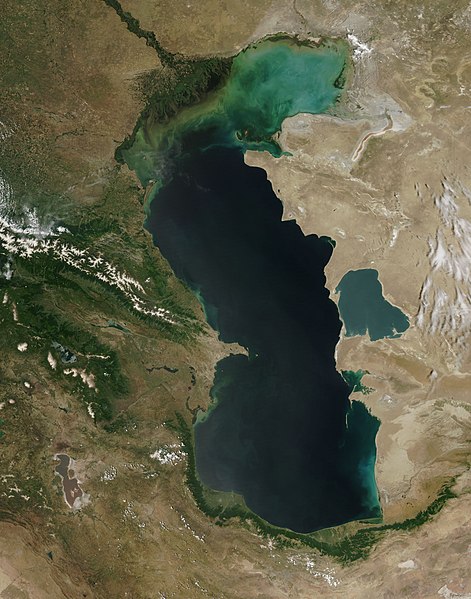Lêer:Caspian Sea from orbit.jpg

Grootte van hierdie voorskou: 471 × 599 piksels. Ander resolusies: 188 × 240 piksels | 377 × 480 piksels | 603 × 768 piksels | 804 × 1 024 piksels | 1 609 × 2 048 piksels | 4 400 × 5 600 piksels.
Oorspronklike lêer (4 400 × 5 600 piksels, lêergrootte: 3,44 MG, MIME-tipe: image/jpeg)
Lêergeskiedenis
Klik op die datum/tyd om te sien hoe die lêer destyds gelyk het.
| Datum/Tyd | Duimnaelskets | Dimensies | Gebruiker | Opmerking | |
|---|---|---|---|---|---|
| huidig | 09:16, 14 Junie 2010 |  | 4 400 × 5 600 (3,44 MG) | Originalwana | higher res |
| 15:10, 8 Februarie 2005 |  | 550 × 700 (67 KG) | Pixeltoo | Caspian sea by space Nasa |
Lêergebruik
Die volgende bladsy gebruik dié lêer:
Globale lêergebruik
Die volgende ander wiki's gebruik hierdie lêer:
- Gebruik in als.wikipedia.org
- Gebruik in am.wikipedia.org
- Gebruik in ang.wikipedia.org
- Gebruik in an.wikipedia.org
- Gebruik in arc.wikipedia.org
- Gebruik in ar.wikipedia.org
- بحر قزوين
- ويكيبيديا:صور مختارة/الفضاء والكون/نظرة إلى الخلف
- ويكيبيديا:ترشيحات الصور المختارة/بحر قزوين
- ويكيبيديا:صورة اليوم المختارة/ديسمبر 2016
- قالب:صورة اليوم المختارة/2016-12-23
- مستخدم:قائمة أكبر البحيرات والبحار في المجموعة الشمسية
- ويكيبيديا:صورة اليوم المختارة/يوليو 2020
- قالب:صورة اليوم المختارة/2020-07-16
- ويكيبيديا:صورة اليوم المختارة/يوليو 2023
- قالب:صورة اليوم المختارة/2023-07-26
- Gebruik in arz.wikipedia.org
- Gebruik in ast.wikipedia.org
- Gebruik in as.wikipedia.org
- Gebruik in av.wikipedia.org
- Gebruik in azb.wikipedia.org
- Gebruik in az.wikipedia.org
- Gebruik in bat-smg.wikipedia.org
- Gebruik in be.wikipedia.org
- Gebruik in bg.wikipedia.org
- Gebruik in bh.wikipedia.org
- Gebruik in bn.wikipedia.org
- Gebruik in br.wikipedia.org
- Gebruik in bs.wikipedia.org
- Gebruik in bxr.wikipedia.org
- Gebruik in ca.wikipedia.org
- Gebruik in ce.wikipedia.org
- Gebruik in ckb.wikipedia.org
- Gebruik in co.wikipedia.org
- Gebruik in cs.wikipedia.org
- Gebruik in cv.wikipedia.org
Wys meer globale gebruik van die lêer.



